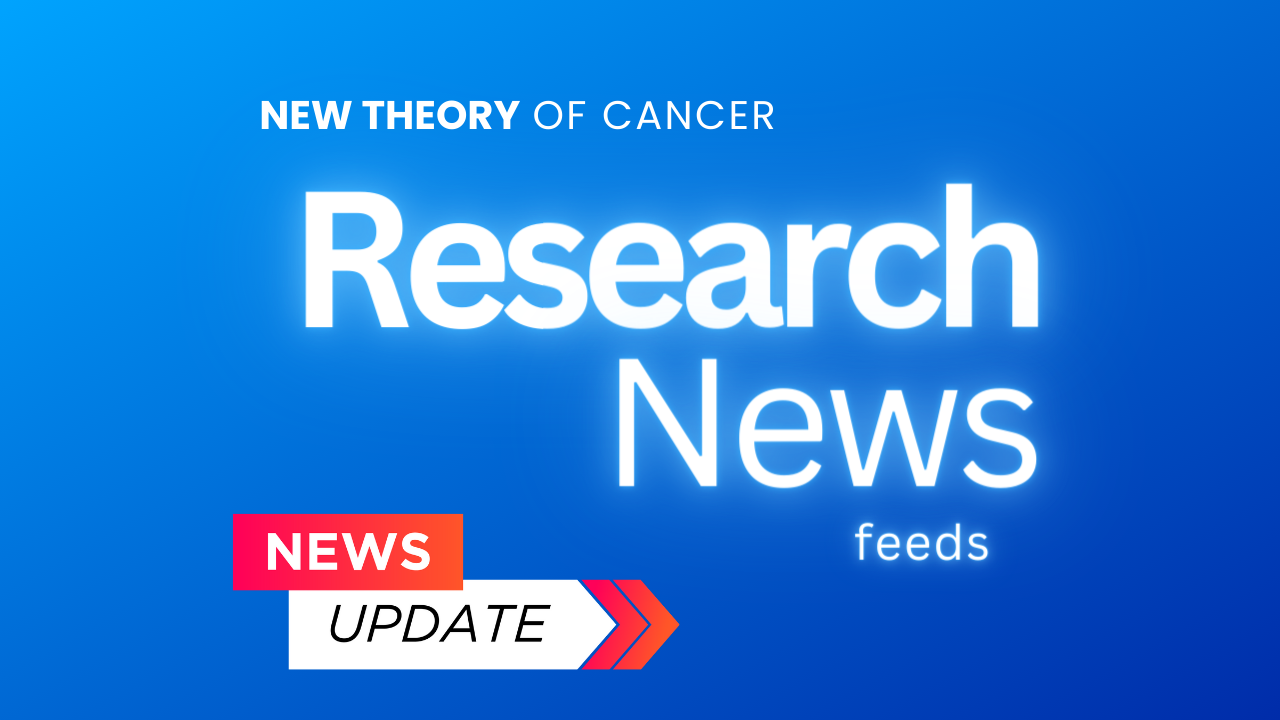The fourth day of the AACR Annual Meeting 2025, a sunny and beautiful day in Chicago, featured exciting results about the efficacy of single-dose HPV vaccinations, therapeutic advances in lung cancer, and innovative technologies that could help drive cancer research forward. Read on for the takeaways from Monday, April 28 to get a flavor of today’s offerings and keep an eye on Cancer Research Catalyst, the official blog of the AACR, for more in-depth coverage of some of the cutting-edge science being presented at the AACR Annual Meeting 2025.

Exciting Technologies Highlighted in Third Plenary Session
Alberto Bardelli, PhD, opened today’s Plenary Session, “Innovative Technologies Driving Advances in Cancer Research,” by challenging attendees to think about how much harder their research would be without the technologies we’ve come to rely on, setting the stage for four examples of continued innovation that can improve the field of cancer research.
Matthias P. Lütolf, PhD, showed off his creative “minicolon” model, in which the shape of cell- and patient-derived organoids is manipulated to better recapitulate the structure and function of an actual intestine, with applications for tracing cell lineages and performing drug screens. Cancer Research Catalyst covered this exciting research last year in our From the Bench series.
Marcela V. Maus, MD, PhD, showed how knocking out the interferon gamma receptor in chimeric antigen receptor (CAR) T cells could enhance the cells’ efficacy. She also demonstrated how CRISPR knockout screens could be used to identify other ways to modify CAR T-cells for enhanced therapeutic potential. Trevor Pugh, PhD, then discussed the promise of liquid biopsies for detecting cancer, monitoring therapy response, and reconstructing the genomes of primary tumors that have been significantly damaged by therapy.

Finally, Muhammad Shaalan Beg, MD, MBA, encouraged attendees to think of clinical trial design more like an evolving technology. He advocated for the consideration of telehealth, remote monitoring, mobile nursing, and other tools to promote decentralized clinical trials.
“We need to urgently deploy these methods, redefine what’s feasible, redefine … who our customers for clinical trials are, and how we can innovate on these in a way that improves clinical trial access and helps us speed up the development of cancer treatments,” Beg concluded.
Panel of Global Cancer Researchers Shared Their Perspectives During the Presidential Select Symposium
Patricia M. LoRusso, DO, PhD (hc), FAACR, ended her tenure as 2024-2025 AACR President with the “Presidential Select Symposium: Leveraging Science to Reduce the Cancer Burden Worldwide.”
“Cancer is a global disease—it spares no continent, no country. And each patient that gets the disease deserves treatment,” LoRusso explained as the reason she picked this topic for the symposium. She worked with the session chair, Robert Bristow, MD, PhD, to assemble a panel of eight participants to represent cancer research being conducted around the world.
Aimée R. Kreimer, PhD, revealed for the first time unblinded results from the NCI-sponsored ESCUDDO trial that compared the incidence of HPV16/18 persistent infection in 20,330 girls between ages 12 and 16 in Costa Rica who received either one or two doses of an HPV vaccine (either Cervarix or Gardasil 9). In potentially practice-changing results, one dose was no less effective than two doses in protecting against HPV16/18 infection, with either dosage resulting in at least 97% vaccine efficacy.
“A lot of countries with very large birth cohorts of girls still have yet to introduce HPV vaccination,” she explained. “A global single-dose HPV recommendation should facilitate country introductions and vaccine uptake.”
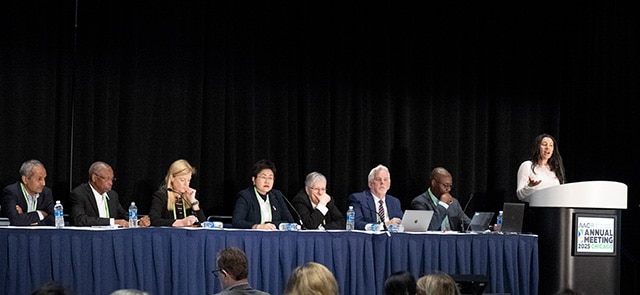
Satish Gopal, MD, MPH, discussed his time conducting research in Malawi. Despite being the only medical oncologist in the country, he said they were able to upgrade the diagnostic infrastructure in the country at a modest investment of time and money.
“The lack of infrastructure is probably the most frequently cited reason why researchers don’t want to engage with collaborators in low- and middle-income countries, but that problem is actually quite easily overcome and frequently overstated,” he said.
Sok Ching Cheong, PhD, described her work in Malaysia developing a mobile health tool that connects an individual with a specialist who can provide an exam for oral cancer as well as follow-up exams if needed. However, she emphasized that not all innovative ideas require technology.
“There are many screening strategies right now that work, but they’re not getting to the right people,” Cheong explained. “We need to innovate the way we deliver these screening methods.”
For example, Vanessa M. Hayes, PhD, talked about the need to engage with trusted tribal healers in parts of Africa to teach them about screening methods that they can perform on their patients.
Frank George Njoroge, PhD, C.S. Pramesh, MD, and André Ilbawi, MD, also offered perspectives from Kenya, India, and WHO, respectively.
“The knowledge that we can gain from each of these individual countries … and components is going to be advantageous and help patients globally,” LoRusso concluded.
Lillian L. Siu, MD, FAACR, Became AACR President
In an event immediately following the Presidential Select Symposium, LoRusso passed the gavel—both figuratively and literally—to Lillian L. Siu, MD, FAACR, officially launching Siu’s term as AACR President.
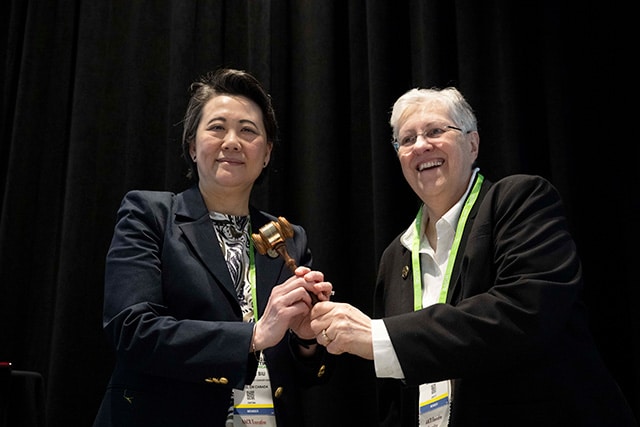
A Spotlight on Lung Cancer Targeted Therapies
Today’s Clinical Trials Plenary Session, the third of four, shined a spotlight on non-small cell lung cancer (NSCLC) and a handful of targeted therapies being tested in the clinic.
The session opened with an update from the Beamion LUNG-1 study, a phase I clinical trial evaluating the safety and efficacy of the novel human epidermal growth factor receptor 2 (HER2) inhibitor zongertinib in patients with previously treated HER2-mutated NSCLC. John V. Heymach, MD, PhD, showed that the drug elicited objective responses and disease control even in patients with rare HER2 mutations that lie outside the tyrosine kinase domain, as well as patients who were previously treated with a HER2-targeted antibody-drug conjugate, the only HER2-targeted therapy currently approved by the U.S. Food and Drug Administration (FDA) for HER2-mutated NSCLC.
The session also featured data on new generations of epidermal growth factor receptor (EGFR) and ROS1 inhibitors. The EGFR inhibitor aumolertinib is currently approved in China for patients with treatment-naïve locally advanced or metastatic NSCLC with an EGFR exon 19 deletion or L858R mutation, but Shun Lu, MD, PhD, showed that combining aumolertinib with chemotherapy resulted in a longer progression-free survival. In another phase I trial, Hongyun Zhao, PhD, showed that the ROS1 inhibitor JYP0322 could elicit responses in patients with ROS1-positive NSCLC, including those who had brain metastases and those who were previously treated with ROS1 inhibitors.
Results weren’t quite as uplifting for the TIGIT-targeted antibody tiragolumab, which did not meet its primary endpoint in the phase III SKYSCRAPER-01 clinical trial. In patients with previously untreated locally advanced or metastatic NSCLC expressing high levels of the immune checkpoint PD-L1, no significant difference in outcomes was observed whether patients received the PD-L1 inhibitor atezolizumab (Tecentriq) alone or in combination with tiragolumab.
“I’m convinced that further data … are needed to identify the patient population who potentially could benefit from combining an anti-PD-1 or anti-PD-L1 strategy with the inhibition of the TIGIT pathway,” said Solange Peters, MD, PhD, who presented the study.
Four Additional Agents Unveiled During Third New Drugs on the Horizon Session
Organized by the AACR Chemistry in Cancer Research (CICR) Working Group, the New Drugs on the Horizon sessions provides a stage for the first public disclosure of new treatments and their biochemical structures, and aim to cover a diversity of modalities, according to Frederic Zecri, PhD, the session chair and a member of the CICR Working Group Steering Committee.
“As you can see, we have a rich panel,” added Zecri, referencing the four approaches presented in Monday’s session.
Three of the therapies target distinct proteins associated with malignant behavior. The radionuclide therapy BAY 3547926 targets the tumor-associated protein GPC3 to deliver destructive radiation locally to tumors, via a 225Ac-GPC3 therapeutic agent, whereas M0324 is designed to stimulate the CD40 immune signaling pathway—but only if the MUC1 protein commonly expressed by cancer cells is nearby. Another, AZD0022, targets the G12D variant of the often-mutated KRAS protein that drives aggressive activity in colorectal, lung, and pancreatic cancer especially. The final new therapy presented, GSK4418959 (IDE275), is a reversible inhibitor of the Werner syndrome (WRN) helicase, an enzyme crucial for DNA repair and replication as well as genome stability, developed for use in patients with cancers characterized by high microsatellite instability.
Tracking Cancer with Circulating DNA
“This whole field has been driven forward by different technological advances … but also in recent years in prospective studies and randomized and interventional clinical trials,” said Lars Dyrskjøt, PhD, MSc, the chair of the “Liquid Biopsy: Circulating Nucleic Acids” Minisymposium, during his introduction.
One illustrative example is the VICTORI trial that was presented by Emma Titmuss, MSc, who demonstrated the power of an ultrasensitive liquid biopsy assay capable of detecting circulating tumor DNA (ctDNA) as low as a few parts per million, and as soon as two weeks after patients with colorectal cancer underwent resection. This technology identified all cases of clinical recurrence in patients before imaging could, by a median of more than six months, offering the possibility for doctors to intervene earlier. Furthermore, the team found that the earlier ctDNA was detected, and the higher the ctDNA level at first detection, the greater the risk of earlier clinical relapse.
Valsamo Anagnostou, MD, PhD, gave an exciting presentation on her team’s efforts to address some of the limitations of assessing immunotherapy responses using only mutation-based liquid biopsy methods. Instead, the researchers interrogated the entire cell-free DNA fragmentome in the blood of patients with lung cancer, which enabled them to accurately predict durable clinical benefit and survival better than with traditional mutation-based assays.
“This is truly exciting in terms of the clinical impact, because we’re starting with really low quantities of cell-free DNA, down to one nanogram in a few milliliters of plasma, so this is a very clinically feasible approach,” said Anagnostou.
An Atlas for AML
In the Minisymposium “Cutting-Edge Advances in Hematology: CAR-T Therapy, B-cell Transformation, Leukemia Mechanisms, and Targeted Drug Development,” researchers highlighted advances in our understanding of hematologic malignancies and how to better target them. One group unveiled a novel comprehensive atlas of hematopoietic cell differentiation and demonstrated how they used it to map various ways differentiation can go wrong in acute myeloid leukemia (AML).
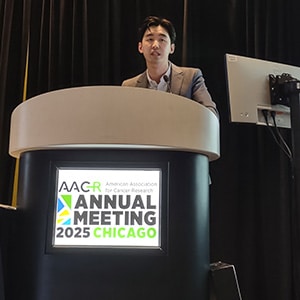
Andy Zeng, PhD, explained that AML is an incredibly heterogeneous disease, and not all of that heterogeneity can be explained by genetic mutations alone. He and his colleagues sought to characterize the different gene expression patterns that define various AML cell states so that researchers can better define and target different types of AML cells.
First, they used single-cell RNA sequencing to build a reference map of normal hematopoiesis, which Zeng said has been a challenge in the field thus far. They then mapped 1.2 million leukemia to distinct cell states and identified 12 differentiation patterns characteristic of AML. Using bulk sequencing data from more than 1,200 samples, the researchers correlated the cell states with genetic driver mutations and found that the same mutation could send cells down separate differentiation trajectories depending on the cell of origin and/or any co-occurring mutations.
Other talks in the session demonstrated how a better understanding of AML biology may lead to better therapies. Several talks highlighted how modulating different signaling pathways can promote sensitivity or resistance to various therapies. The session also featured a handful of new drugs developed to inhibit new and emerging drug targets.
Learn more about the robust Annual Meeting programming centered around hematologic malignancies. For more information about Zeng and colleagues’ study, read their concurrent publication, along with an accompanying commentary, in the AACR journal Blood Cancer Discovery.
Shining Light on Rare Tumors
Rare cancers cumulatively account for almost a quarter of all cancers in the United States, a statistic that motivated the program chairs of this year’s Annual Meeting to make sure these cancers were well represented in the scientific program. Several presentations today delved into strategies for improving rare disease research and patient care.
During the “Rare Cancers: Role of Precision Genomics, Immunotherapy, and Novel Molecular/Clinical Trial Approaches” session, researchers examined how the treatment of rare cancers can inform therapeutic strategies for other cancer types, discussed the DART platform trial evaluating immunotherapy for rare cancers, and offered perspectives on the challenges of treating rare cancers in India.
And during today’s Poster Sessions, Adam Thiesen reported an artificial intelligence (AI)-driven model to facilitate subtyping of pediatric sarcomas, which are rare and diverse tumors forming in various soft tissues. Typical subtyping methods for these cancers are complex and require resources not available in many settings, Thiesen explained, but the new AI-driven model accurately classified sarcomas using only routine digital pathology slides. The model was trained using imaging data from four different institutions, representing the largest multicenter collection of pediatric sarcoma images to date.
“This AI-driven model could help provide more pediatric patients access to quick, streamlined, and highly accurate cancer diagnoses regardless of their geographic location or health care setting,” Thiesen noted.
Learning From Other Species
Today’s “Comparative Oncology: Nature’s Solutions to Cancer Prevention” session showed how studying cancer in animals informs the understanding of human cancers, a topic in which AACR members had expressed high interest in a survey.
The first speaker, Amy Boddy, PhD, discussed cancer prevalence across vertebrate species and why certain species might be more prone to cancer than others. She reported that cancer prevalence increases with body mass and decreases with gestation time, findings that were examined in a recent AACR blog post. Boddy also shared data indicating that mammals that are carnivorous are more likely to die from cancer and that non-human primates develop different types of cancer than humans do.
Additional presentations during the session discussed how performing comparative genomics analyses in primates can identify new cancer drivers and how comparative oncology approaches can uncover mechanisms of longevity and cancer resistance.
“We’re looking at this diversity of life on Earth across species and various environments. We can think of these as natural experiments to understand cancer biology and development but also cancer resistance mechanisms in species that rarely get cancer,” said Boddy.
GENIE Grants Researchers’ Wishes
Ten years ago, the AACR launched its Genomics Evidence Neoplasia Information Exchange (Project GENIE®), a publicly accessible registry of real-world, clinico-genomic data. In a Minisymposium today, six researchers shared how they’re using AACR Project GENIE data to advance our understanding of cancer biology.

One group is evaluating a way to predict patient outcomes by examining the loss of heterozygosity in human leukocyte antigen (HLA) genes. Another has employed machine learning technologies similar to ChatGPT to find patterns in somatic mutations. Other researchers used AACR Project GENIE to understand how a pair of oncogenic mutations support a vicious cycle of lung cancer growth.
An advantage of AACR Project GENIE is the sheer number of available samples, allowing researchers to find patterns in uncommon disease types that may not be as evident in smaller datasets. Experts used the database to profile the mutational landscape of metaplastic breast cancer and probe potential therapeutic vulnerabilities in early-onset colorectal cancer and cervical cancer.
To learn more about AACR Project GENIE, rewatch Saturday’s Methods Workshop on the virtual platform and read about their events held during the AACR Annual Meeting 2024.
Special Sessions Highlighted AACR’s Collaborations and the Importance of Effective Science Communication
Three Special Sessions highlighted just a few of AACR’s many collaborations, including with the Japanese Cancer Association (JCA), the American Society of Clinical Oncology (ASCO), and Stand Up To Cancer (SU2C). The AACR-JCA Joint Session shared insights into the mechanisms that impact neural and neuronal differentiation to promote tumor development and progression; the AACR-ASCO Joint Session examined challenges and opportunities in theranostics, an approach that combines cancer detection with cancer treatment; and the SU2C Open Scientific Session discussed advances in the detection and treatment of gastrointestinal cancers.
Organized by the AACR Trust in Science Task Force, the “Special Session on Using Communication Effectively to Foster Trust in Science, Cultivate Engagement, and Improve Clinical Trial Participation” featured presentations about building trust through community-centered clinical trials, the patient perspective on building trust through engagement and communication, and countering misinformation.
Distinguished Scientists Delivered Award Lectures
Several award lectures also took place today, providing attendees the opportunity to hear from some of the field’s leading pioneers.
Christopher R. Flowers, MD, delivered the AACR-Minorities in Cancer Research Jane Cooke Wright Lectureship on “Addressing disparities in lymphoma outcomes.” He received the lectureship in honor of his groundbreaking contributions to understanding disparities in lymphoma incidence, treatment, and outcomes, particularly in underrepresented and understudied patient populations.

William N. Hait, MD, PhD, FAACR, discussed “From academia to industry: An incredible journey in innovation” as the recipient of the AACR-Margaret Foti Award for Leadership and Extraordinary Achievements in Cancer Research in recognition of his extensive contributions to cancer pharmacology, drug discovery, and precision medicine.
Shiva Malek, PhD, delivered her award lecture, titled “Targeted therapies in cancer: The past, present, and future.” Malek received the AACR Award for Outstanding Achievement in Chemistry in Cancer Research for her contributions to the chemical biology of kinase signaling.
Alice T. Shaw, MD, PhD, presented “From breakthrough to benchmark: Generational leaps in targeted therapies” as the recipient of the AACR-Joseph H. Burchenal Award for Outstanding Achievement in Clinical Cancer Research. Shaw was recognized for her clinical and translational research that has transformed the treatment of oncogene-driven lung cancers.
Charles G. Mullighan, MBBS (Hons), MSc, MD, recipient of the AACR-St. Baldrick’s Foundation Award for Outstanding Achievement in Pediatric Cancer Research, spoke about “Dissecting the genome of acute lymphoblastic leukemia.” Mullighan received the award in honor of his groundbreaking genomic discoveries that have reshaped the classification, diagnosis, and treatment of childhood acute lymphoblastic leukemia.
Han Liang, PhD, discussed “AI, big data, and cancer medicine” as the recipient of the AACR Award for Outstanding Achievement in Basic Cancer Research, which was awarded to Liang for his celebrated contributions to cancer bioinformatics and systems biology.
Karen H. Vousden, PhD, FAACR, presented “Metabolic control of cancer progression.” Vousden received the AACR-G.H.A. Clowes Award for Outstanding Basic Cancer Research for her discoveries in tumor suppressor biology and cancer metabolism.
Scientific Working Groups Held Town Hall Meetings
This evening included Town Halls hosted by the AACR Working Groups on Cancer Evolution, Cancer Prevention, Chemistry in Cancer Research, Hematologic Malignancies, and Tumor Microenvironment. A joint reception was held before the Town Halls, allowing members of different Working Groups to network with one another.
Enjoy photos of yesterday’s Town Hall reception, which preceded the Town Halls of the AACR Working Groups on Cancer Immunology, Pathology in Cancer Research, Pediatric Cancer, Population Sciences, and Radiation Science and Medicine.

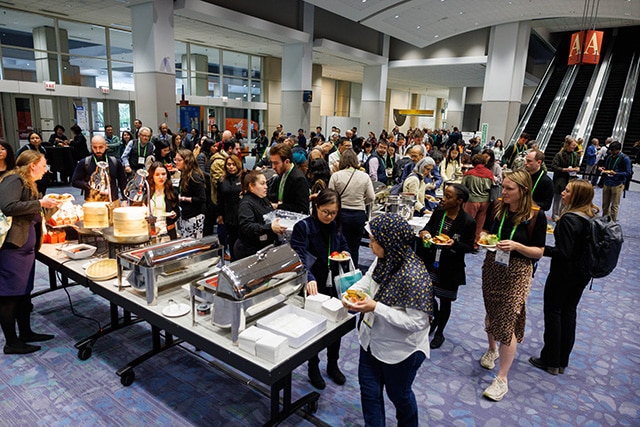
Visit the virtual platform to view any of the scientific sessions or e-posters through October 2025. For more coverage of the meeting, go to AACR Annual Meeting News, check out the takeaways from each day, and subscribe to Cancer Research Catalyst.
The post Daily Takeaways From the AACR Annual Meeting 2025: Monday, April 28 appeared first on American Association for Cancer Research (AACR).


